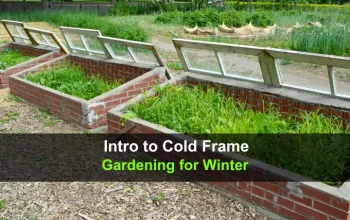Estimated reading time: 13 minutes
Growing food in five-gallon buckets allows you grow a lot of food in a tiny space, even on a porch or balcony. You can grow some surprisingly large plants, even fruit trees. And if you have space indoors, you can grow food throughout the year.
It’s always best to use a brand new bucket when growing crops. Buckets get filled with all kinds of junk, fluids, and garden scraps that could kill your plants or make them harmful to consume.
A bucket that has previously housed swimming pool chemicals, asphalt, or chemical pesticides should be avoided entirely. Plant diseases are often spread by the use of contaminated tools and containers. If you do get a used bucket, make sure it’s a food-grade bucket that never contained anything inedible.
Plastic buckets are far more suited for growing food than metal ones. Metal buckets will rust and allow the rust to leach into the soil and ultimately, your food source.
Want to save this post for later? Click Here to Pin It On Pinterest!
5-Gallon Bucket Planting Pros And Cons
Pros
You can make use of every little patch of sunlight around your home. It would be highly problematic to place a raised bed on your back patio, but putting a few buckets with plants in the same space would be quite easy – and it will give you the same yield as a raised bed.
Five-gallon buckets have plenty of space for the roots of most vegetables and dwarf fruit trees. Some plants require only six inches of dirt to thrive, but others need up to 24 inches of root space.
You can still take advantage of companion planting to help each crop thrive and to thwart destructive insects.
Five-gallon buckets are portable. Being able to move the buckets inside during weather emergencies or take them with you during a bugout will keep your food source from being destroyed.
You can grow non-native crops since they can be moved indoors or into a greenhouse. A typical backyard deck has enough space to grow enough dwarf fruit trees to garner the same yield as a small orchard.
You can quickly and easily protect your container garden from the threat of frost by simply throwing sheets or a roll of plastic over it.
There is far less weeding involved with a five-gallon bucket garden than is required with a traditional ground plot or raised bed. To make the weeding chore even less taxing, place the buckets onto a bench or stool so you don’t have to repeatedly bend over to pull unwanted weeds.
Five-gallon buckets let you control the soil quality and composition. By selecting your own mix of soil, compost, and other amendments tailored to each type of plant, you can optimize growth conditions and ensure healthier, more productive crops.
Bucket gardening is more water efficient. By watering individual containers, you can tailor moisture levels precisely to the needs of each plant, avoiding the overwatering that occurs in larger garden plots. This is especially beneficial during drought conditions or in areas with water-use restrictions.
Cons
The only real con to growing in 5-gallon buckets, or any type of container garden, is the watering chore. The container can easily become either waterlogged or dried out. Drilling a sufficient number of holes in the bottom of the 5-gallon buckets is essential, but consistent checking of the soil for moisture or dryness will still be necessary.
To check the soil of a food growing container, press a finger into the dirt down to the second knuckle. If the soil is moist at this level, you do not need to water.
Many container gardeners buy or make a self-watering system for each bucket so they can tackle this ongoing chore more easily. Watch the video below to learn how.
Best Vegetables To Grow In Buckets
| Crop | Amount per Bucket |
|---|---|
| Beets | 4 sets |
| Broccoli | 1 plant |
| Cabbage | 1 plant |
| Carrots | 10 plants |
| Collard greens | 2 plants |
| Cucumbers | 1 plant |
| Eggplant | 1 plant |
| Garlic | 6 bulbs |
| Green Beans | 2 plants |
| Kale | 2 plants |
| Lettuce | 4 plants |
| Onions | 4 sets |
| Peas | 3 plants |
| Peppers | 2 plants |
| Potatoes | 3 plants |
| Radishes | 10 plants |
| Spinach | 4 plants |
| Squash | 1 plant |
| Swiss chard | 2 plants |
| Tomatoes | 1 plant (staked or caged) |
| Zucchini | 1 plant |
Best Fruits To Grow In Buckets
Blueberries – You will need to grow a minimum of two blueberry plants in separate containers near each other to garner a quality yield. The berry should produce from early June through August. The fruit bushes need 18 inches of soil for their roots to take hold. Grow the bushes in a peat based and acidic soil.
Dwarf Banana – You can easily grow miniature banana plants in 5-gallon buckets, but you will have to move them indoors when the temperature drops below 65 degrees. Place the plants in a window that gets full sun or hang a grow light above them during the winter. Mist the plants periodically so they don’t get too dry.
Figs – The bucket used to grow the fig must be 16 inches in diameter. They need well-drained soil and full sun. During times of intense heat, the figs will need to be watered sometimes twice a day so they don’t dry out.
Passion Fruit – This perennial vine will only have to be planted once. A sturdy trellis will need to be staked into the 5-gallon bucket to support the weight of the passion fruit plant as it grows and becomes laden with fruit.
Strawberries – Everbearing strawberries are highly recommended for container growing because they produce two yields per year – one in the early June and one in the late summer.
Bucket Garden Growing Tips
• Bush style beans are better suited for container gardening than other varieties of green beans.
• You can grow potatoes in 5-gallon buckets if you drill holes large enough fit your hand inside around the bucket from 2 inches above the base all the way to 2 inches below the rim. Follow potato barrel growing instructions to cultivate a smaller scale crop.
• When growing herbs, you can typically cultivate at least six plants in a single 5-gallon container. If growing herbs that do not tend to sprawl or become exceptionally bushy, like rosemary, chives, thyme, cilantro, and basil, you can usually fit 8 to possibly 10 plants without overcrowding them.
• Carrots must be grown in loose soil so their roots develop properly. Growing carrots in rocky or compacted soil typically produces poor results.
• Mulching your bucket plants will help retain moisture and suppress weeds. Use organic mulch like straw or wood chips. This will also help keep the soil temperature more stable.
• Consider adding a layer of gravel or small stones at the bottom of your buckets before adding soil. This improves drainage, preventing root rot and other moisture-related issues.
• Rotate your buckets on a regular basis to ensure every plant is getting plenty of sunlight. This helps prevent the plants from leaning too heavily towards the light source, promoting stronger and more balanced growth.
• To keep destructive insects at bay, introduce nematodes into the soil or make a super cheap insecticide soap. To make the soap, combine five tablespoons of Blue Dawn liquid dish soap with 1 gallon of water. Spray the plants in the early morning hours to avoid scorching and to give them time to dry before dark to avoid the chances of mold growth.
• Combine 1 part flour with 1 part salt and sprinkle the mixture onto the leaves and around the base of the 5-gallon buckets to kill bugs. The bugs will consume the mixture and it will dehydrate them from the inside out after causing them to swell immensely. The downfall to both this treatment and the insecticide soap is that it kills beneficial insects along with the harmful ones.
Bucket Garden Mistakes To Avoid
Here are the top mistakes that you would be wise to avoid when growing food in buckets:
Planting Too Many In One Bucket
One of the biggest mistakes you can make is trying to plant too many plants or crops in a single bucket. Buckets have a limited amount of space, which means the number of nutrients is also very limited. More plants in the bucket will result in slowed growth and less yield overall.
Choosing Buckets That Are Too Small
Make sure your buckets are at least five gallons at the absolute minimum. Even though the whole purpose of using buckets is to use up less space, you don’t want to go too small, or else the plants won’t have enough room to grow. Crops that have too little space will grow slower and also turn out unhealthy.
Insufficient Light
Regardless of where you choose to set out your plants, you must make sure they get enough light. You need to analyze the sun throughout the day in relation to your selected location. Leafy greens will need at least four hours of sunlight per day, while vegetables will need at least eight hours (but be careful to research the specific crop you are growing).
Too Much or Too Little Water
You will need to pay extra close attention to watering crops and plants that you are growing in buckets. Crops grown in a more limited amount of space require additional water than plants grown in larger beds.
This is especially true during the hot summer months. Water your plants in your buckets at least twice a day (but again, research the specific plants you’re growing).
Forgetting To Prune
If you prune your plants, you will greatly improve their yield and health. Focus on areas where the foliage is denser. Doing so will allow the sunlight to hit the leaves located underneath. As a result, the plant will focus on producing more yield rather than focusing on saving additional branches or leaves.
Forgetting To Fertilize
Fertilizing crops is even more important in a bucket because of the limited space (meaning they use up the reduced nutrients faster). Mix in compost or fresh soil at the beginning of the planting and add liquid fertilizer at least twice monthly.
Overlooking Pest and Disease Monitoring
If you forget to regularly inspect your bucket plants for pests and diseases, it can lead to significant problems down the line. Check your plants frequently for signs of distress, such as discolored leaves, stunted growth, or visible pests. Early detection is key to managing potential outbreaks and keeping your garden healthy.
Ignoring Seasonal Adjustments
Just because you’re not growing food in the ground or raised beds doesn’t mean you shouldn’t take the seasons into account. As sunlight and temperatures vary, so do the needs of your plant. In the summer, they may need more water and more shade. And in the winter, they may need less water and more sunlight.
How To Choose The Right Kind Of Soil
Not all dirt is created equal. It is vital to the growing process that you buy or compile the right type of soil for container gardening. Even though the plants can grow in subpar dirt, the anticipated yield will most likely be far less than desired.
There is a big difference between topsoil and potting soil.
Topsoil is composed of dirt scraped from fields and is mixed with compost, sand, and manure – among other natural ingredients. Topsoil is designed to provide a much denser planting mixture than potting soil.
Unlike topsoil, potting soil is sterilized. This significantly reduces the chance of any plant fungus or diseased matter harming your seeds or plants. It also helps to sift out other possible impurities like insect eggs, larvae, or weed seeds.
Potting soil often doesn’t contain any soil at all. Potting soil varieties contain bark, sphagnum moss, vermiculite, coconut or coir husk, and peat moss. Peat moss expels water instead of soaking it up. The first time you water the 5-gallon bucket containers, they will require a bit of extra tending.
Mix a small amount of slow-release fertilizer with the potting soil. This type of fertilizer is always best to use in container gardening so the plants don’t become overwhelmed. Then, mix the potting soil with a bit of water, add it to the container, and repeat this until the container is full to ensure the plants garner enough moisture.
When these ingredients are mixed together, they form a solid texture that helps growing roots. Potting soil offers much better drainage than topsoil, which is extremely important when growing in containers.
To make your own potting soil, mix together:
- 1 part composting material
- 1 part vermiculite or perlite
- 1 part peat moss
- 1 part small gravel
- ½ part sand
- ½ part tiny bark chunks

DIY 5-Gallon Bucket Planter
Supplies:
- Plastic bucket
- 50 – 50 compost and potting soil mix
- Plants
- Small rocks
- Burlap and twine – optional for wrapping buckets
- Power drill with a half inch bit
Directions:
- Turn each 5-gallon bucket upside down and drill up to five drainage holes in the bottom. Never put too much pressure onto the drill when making the holes as doing so can cause the bucket to crack.
- If you want to paint the buckets to make them either more attractive or covert, do so now. I highly recommend scrubbing the outside of the bucket with equal parts ammonia and water to scuff up the plastic finish enough to permit the paint to adhere to it. You can also wrap some burlap around the bucket to give them a decorative look and to add a bit of insulation. Simply tie a piece of twine over top of the burlap and knot if after wrapping the covering around the bucket.
- Fill the base of the 5-gallon bucket with a single layer of small rocks to help facilitate proper drainage. The layer of rocks should be about two to three inches deep.
- Add a layer of potting soil and water it lightly.
- Repeat step four until you are within 1 inch of the rim of the 5-gallon bucket.
- Add the desired seeds or plants into the bucket. If planting tomatoes, I highly recommend planting basil at the base not only to enhance flavor but to ward off destructive insects as well.
Repeat each step for all of the 5-gallon buckets you are using to establish your container garden. The video below shows what can be accomplished with a bucket garden.
It is also possible to grow vertically with 5-gallon buckets to increase your crop cultivation space. You can stack buckets on top of each other to grow root crops like potatoes, onions, beets, and carrots as long as you cut wide holes into the sides of the bucket with a power drill. A clothesline style vertical setup can be used to hang two rows of buckets without casting too much shade on the lower containers.
How you choose to lay out your portable garden will depend on both the dimensions of your property and the spaces which offer enough sunlight for the plants to thrive.
Do not crowd the buckets too closely together. Each plant will need proper ventilation in order to reach its full potential. Spacing the buckets at least six inches apart will also make it a little bit harder for insects to traverse from one plant to another.
When purchasing buckets for your container garden, try to find some that have been manufactured to food grade standards. If using an old bucket to grow crops, wash it with warm and soapy water and dry it thoroughly.
Next, scrub it inside and out with distilled white vinegar to completely disinfect it. You can rinse out the bucket after cleaning it with vinegar or simply allow it to dry outdoors in the sun.
Conclusion
Growing food in five-gallon buckets is a practical solution for people with limited space. As long as you understand the specific needs of bucket gardening—such as choosing the right buckets, using the right soil mix, and managing water and light effective—you can cultivate a thriving garden right on your balcony or patio.
Remember to avoid common mistakes like overcrowding, poor draining, and neglecting plant health. With these tips in mind, you’re well on your way to enjoying fresh, home-grown produce. Happy gardening!
Like this post? Don’t Forget to Pin It On Pinterest!
You May Also Like:




